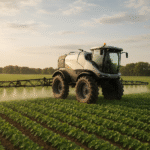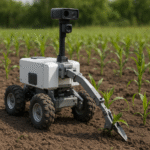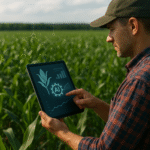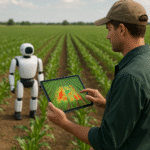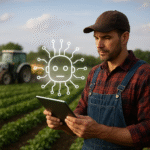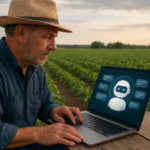The advent of intelligent digital assistants is revolutionizing the agricultural landscape, empowering farmers with real-time guidance and transformative insights. AI chatbots are swiftly evolving from simple query responders into sophisticated advisers capable of analyzing weather patterns, soil conditions, and market trends. By leveraging cutting-edge technologies, these virtual companions drive precision farming, mitigate risks, and unlock new levels of operational efficiency. This article explores the integration of AI chatbots into modern agriculture, highlighting their impact on decision-making, sustainability, and the future of food production.
AI Chatbots as Virtual Field Advisors
In the realm of optimization and resource management, AI chatbots serve as round-the-clock assistants for farmers. They interpret complex datasets through intuitive conversational interfaces, transforming raw information into actionable steps. Rather than sifting through pages of technical manuals, growers can pose natural-language questions and receive tailored recommendations. Key functions include:
- Soil Analysis: By uploading sensor data or images, farmers obtain instant feedback on nutrient levels, moisture content, and pH balance.
- Crop Health Monitoring: Chatbots analyze photos for pest infestations, fungal outbreaks, or nutrient deficiencies and propose integrated pest management strategies.
- Weather Forecast Integration: Real-time updates on rainfall, temperature shifts, and frost risks help in scheduling planting, irrigation, and harvesting.
- Equipment Guidance: Virtual assistants recommend optimal machinery settings, reducing fuel consumption and wear on tractors, harvesters, and sprayers.
Through machine-learning algorithms, these chatbots continuously refine their expertise by absorbing regional data, historical yields, and evolving agronomic research. Farmers benefit from on-demand expertise without needing a technical background, thus democratizing access to predictive analytics.
Integrating Data Streams and Machine Learning
The true power of AI chatbots emerges when they aggregate multiple data sources into a cohesive advisory platform. Integration of satellite imagery, drone footage, weather stations, and IoT-enabled sensors enables a panoramic view of farm operations. Chatbots harness this diverse input to:
- Generate yield projections that incorporate soil fertility trends and market price fluctuations.
- Recommend irrigation schedules based on evapotranspiration rates and reservoir levels.
- Identify optimal planting windows by cross-referencing historical climate data and real-time forecasts.
Machine-learning models digest this wealth of information to produce context-aware insights. For instance, if a particular field shows signs of nitrogen depletion, the chatbot calculates the precise fertilizer dosage needed to restore balance while minimizing environmental runoff. Similarly, predictive models alert farmers to upcoming drought conditions, enabling preemptive soil amendments or crop switches.
Seamless Connectivity
Connectivity plays a pivotal role in scaling these solutions. Cloud-based platforms ensure that chatbots remain updated with the latest agronomic studies and weather patterns. Even in areas with intermittent internet access, chatbots can operate in offline mode, syncing data once connectivity is restored. This continuous loop of communication and learning fosters a truly intelligent support system.
Key Benefits of AI-Driven Decision Support
- Efficiency: Task automation reduces manual labor, freeing up time for strategic planning.
- Resilience: Early detection of threats such as pests, diseases, or extreme weather bolsters farm resilience.
- Sustainability: Precision recommendations lower chemical inputs and water usage, promoting environmentally responsible farming.
- Cost Savings: Data-driven interventions reduce waste, optimize resource allocation, and improve overall profitability.
- Adaptation: Dynamic guidance helps farmers respond to market changes, policy shifts, and unexpected challenges.
Enhancing Sustainability and Environmental Stewardship
By delivering targeted, data-backed advice, AI chatbots champion sustainable practices across the agricultural value chain. They encourage farmers to adopt techniques such as:
- Conservation tillage guided by soil compaction analysis.
- Variable-rate fertilizer application adjusted to micro-variations within fields.
- Integrated pest management that relies on predictive pest migration models rather than blanket chemical treatments.
- Cover cropping schedules optimized for carbon sequestration and soil health rejuvenation.
These strategies not only preserve ecosystem balance but also enhance long-term resilience against climate volatility. By reducing greenhouse gas emissions and minimizing nutrient leaching, growers contribute to broader environmental goals while safeguarding their own yields.
Future Prospects in Smart Farming
The intersection of AI chatbots with emerging technologies promises even greater breakthroughs. Innovations on the horizon include:
- Enhanced voice recognition for seamless hands-free operations during fieldwork.
- Integration with autonomous machinery for fully automated planting, weeding, and harvesting cycles.
- Advanced genomics modules that guide crop breeding programs based on real-time AI analysis of phenotypic data.
- Augmented-reality overlays that visualize chatbot recommendations directly onto live camera feeds.
As rural broadband expands and sensor networks proliferate, the synergy between digital advisors and physical assets will transform every aspect of farming. By amalgamating real-time feedback with historical insights, chatbots will continue to elevate decision-making from guesswork to scientific precision.
Conclusion
AI chatbots represent a pivotal leap forward in agricultural innovation. By empowering farmers with insights that were once confined to specialized consultants, these virtual advisors democratize cutting-edge knowledge across all scales of operation. Through seamless integration of data streams, machine-learning algorithms, and user-friendly interfaces, chatbots are forging a new era of automation, productivity, and sustainability in the fields. As technology advances, their role will only intensify, solidifying AI-driven support as a cornerstone of connectivity in the modern agricultural ecosystem.
